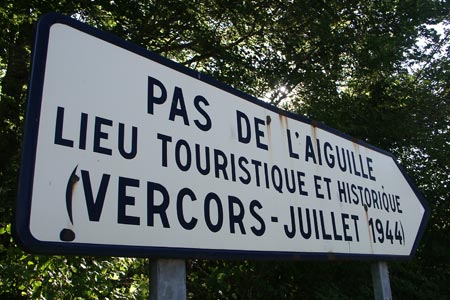Pas de l'Aiguille & Chichilianne from Richardiere
Walk 6077
Country - France
Region - Isere (38) - Parc Naturel Régional du Vercors
Author - Lou Johnson
Length - 14.0 km / 8.8 miles
Ascent - 800 metres / 2640 feet
Descent - 800 metres / 2640 feet
Grade - moderate

Click image to visit gallery of 15 images.
This walk explores a dramatic section of the Vercors which is a range of limestone plateaux and mountains in the départements of Isère and Drôme to the south of Grenoble. The area does not have National Park status instead being a Regional Natural Park. The highest point of the Vercors is Grand Veymont (2346m) although its most memorable peak is Mont Aiguille (2086m), which is seen on this walk. During the Second World War the resistance established the Free Republic of Vercors during 1944 and this walk includes two monuments to those resistance fighters.
The start of the walk is the car park at Richardiere which lies a few kilometres west of the N75 Grenoble to Veynes main road. The drive to the start will introduce you to scenery that is typical of the area including your first view of Mont Aiguille. After parking continue west along the road which soon becomes a gravel track and leads to a further car park after 2 km. at Les Forcheaux where the first monument is passed. From here the track is left behind a path starts the scent onto the plateau surrounded by limestone cliffs. The path twists and turns. In 1.5km you ascend 400 metres to reach the Pas de l'Aiguille where the second memorial is located.
The terrain from here is at best confusing across an undulating limestone plateau. It is difficult to orientate and you need the recommended map to continue. After the Pas de l'Aiguille the path follows a shallow valley to reach a junction of paths at the Refuge de Chaumailloux. Just in case you wondered this does not serve any refreshments! At the path junction turn left. The way ahead is fairly clear. Do not continue unless you are sure you are on the right path which gradually becomes easier to follow. After two or three hundred metres the path goes left at a t-junction and then contours around the northern flank of the Tete des Baumiers (1874m).
The way is generally a little south of east and you pass a small lake (Chamousset). Continuing on the same heading the path cross undulating country. Ahead and to the right is the impressive Montagnette escarpment. You reach an area with a number of small lakes and it is from here that the descent into valley commences. Reaching a signed junction of paths, left turn to the Pas de l'Essaure. After crossing an open area the path descends in zigzags rapidly through conifers. Forest tracks are crossed during the descent.
The path gradually levels off to reach a wide gravel track. Turn left here to cross a river bed to reach another junction of tracks. Turn right here and continue down to a tarmac road. Turn left in Chichilianne from where the road is followed back to Richardiere.
Suggested Maps
 - IGN Carte de Randonnée - Glandasse, Col de ka Croix-haute, PNR du Vercors - 1:25000 Sheet 3237 OT
- IGN Carte de Randonnée - Glandasse, Col de ka Croix-haute, PNR du Vercors - 1:25000 Sheet 3237 OT
 - Promenades et Randonnees - Le Trieves: Autour de Clelles. Available in the excellent Tourist Office in Clelles.
- Promenades et Randonnees - Le Trieves: Autour de Clelles. Available in the excellent Tourist Office in Clelles.
Stay Safe
Do enjoy yourself when out walking and choose a route that is within your capabilities especially with regard to navigation.
Do turn back if the weather deteriorates especially in winter or when visibility is poor.
Do wear the right clothing for the anticipated weather conditions. If the weather is likely to change for the worse make sure you have enough extra clothing in your pack.
Do tell someone where you are planning to walk especially in areas that see few other walkers.
Do take maps and other navigational aids. Do not rely on mobile devices in areas where reception is poor. Take spare batteries especially in cold weather.
Do check the weather forecast before leaving. The Met Office has a number of forecasts for walkers that identify specific weather risks.
Please Note - These walks have been published for use by site visitors on the understanding that Walking Britain is not held responsible for the safety or well being of those following the routes as described. It is worth reiterating the point that you should embark on a walk with the correct maps preferably at 1:25000 scale. This will enable any difficulties with route finding to be assessed and corrective action taken if necessary.